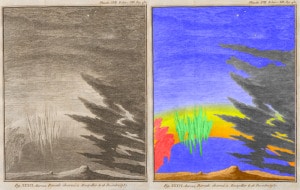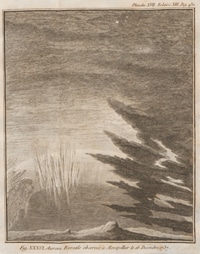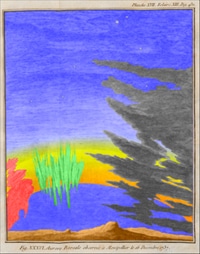The Northern Lights of 1737 revealed

This is the oldest known reproduction of the Northern Lights: this 18th-century black-and-white engraving has just been restored to its original colors thanks to a team bringing together the LIRMM, the CNRS, the University Science Library, andthe IUT in Béziers.
"There were columns, jets of light, and several showers of rays..." On December 16, 1737, astronomers in Montpellier described a fantastic curtain of colors. An exceptional phenomenon observed in Paris and as far away as Italy. Their drawing, the first of its kind, has survived to this day in the form of a black and white engraving included in Jean-Jacques Dortous de Mairan's Traité physique et historique de l'aurore boréale (1754). Gone are the shimmering colors of this spectacular phenomenon...
Graphic puzzle
But while browsing through this book from the University Science Library's historical collection, Elizabeth Denton made a discovery. "The engraver used a graphic code to note the colors: a system of hatching and dots, used since the Middle Ages in heraldry," explains the head of the university library's heritage department. "But code means computer science..."
To restore the colors of the 1737 aurora borealis, all that remained was to entrust the engraving to a computer. "Not so simple!" explains William Puech, head of the ICAR project at the Montpellier Laboratory of Computer Science, Robotics and Microelectronics (LIRMM). "In addition to the textures, the engraver worked hard to render the shades of gray. So we had to restore the gradients at the same time as the colors. It was a real graphic puzzle to solve!"
Long unexplained phenomena
The mystery was solved with the help of Gérard Subsol from the CNRS, as well as two Master's students in computer science and an intern from the IUT, Antoine Noto. "By transferring the image to another color space—YCrCb, which uses the luminance signal (black and white) plus two chrominance signals (blue and red)—and superimposing several image processes, we were able to restore both the color information and the differences in intensity." And to see the reappearance of an aurora borealis observed nearly 300 years ago... A method that could be systematized for other ancient engravings of the same type.
The adventure is also fascinating for historians. "In writing his book, an impressive scholarly work compiling 1,441 observations since the 6th century, de Mairan attempted to shed scientific light on phenomena that were as impressive as they were unexplained," says Elizabeth Denton. It was a way of reassuring the public about these phenomena, which were on the rise in the 18th century... and whose explanation would only be confirmed in 2008, thanks to NASA's THEMIS mission.

